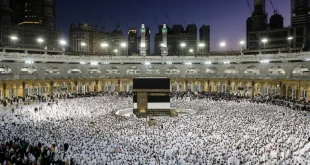 Vision cannot encompass this beautiful sight (the Ka’bah). Each glance return with a greater delight! Glory be to ALLAH TA’ALA for making the Ka’bah the rendezvous of the Ummah, for making Hajj the key expression of solidarity among Believers and as a manifestation of the bond of fraternity and mutual affinity. A journey full of symbolism, for it represents the soul’s journey towards ALLAH. Each stage and each aspect of the pilgrimage is replete with profound meanings about life, worship and realities of faith, especially the love and awe of ALLAH TA’ALA.
Vision cannot encompass this beautiful sight (the Ka’bah). Each glance return with a greater delight! Glory be to ALLAH TA’ALA for making the Ka’bah the rendezvous of the Ummah, for making Hajj the key expression of solidarity among Believers and as a manifestation of the bond of fraternity and mutual affinity. A journey full of symbolism, for it represents the soul’s journey towards ALLAH. Each stage and each aspect of the pilgrimage is replete with profound meanings about life, worship and realities of faith, especially the love and awe of ALLAH TA’ALA.
An observer might wonder at the wisdom underlying the circumambulation, the running and the pelting, but the Muslim should not be concerned about the wisdoms beneath these acts. Render these acts believing them to be the Commands of ALLAH TA’ALA and that HIS remembrance will be grounded in the heart by observing these acts. The relationship of the Believer with ALLAH TA’ALA is strengthened and his/her love is tested. Without understanding the wisdom of these acts, the Muslim is in love with ALLAH TA’ALA, executes them because of the Command of ALLAH TA’ALA. All Commands of ALLAH TA’ALA are carried out because of HIS love. These acts of Hajj are permeated with love. Love overwhelms intelligence regarding Hajj.
The pilgrimage take place each year between the 8th and the 12th days of Dhul-Hijjah, the 12th month of the Muslim lunar calendar. Its first rite is the donning of Ihraam.
By ALLAH TA’ALA whose House (Makkah) the loving pilgrims visit, a beautiful journey begins by responding with the Ihraam at the appointed limit. During Ihraam there is a sense of humility before ALLAH to Whom faces bow in servility. The donning of the Ihraam is accompanied by the primary invocation of the Hajj, the Talbiyah:
Here I am, O ALLAH, at Thy Command! Here I am at Thy Command! Thou art without associate; Here I am at Thy Command! Thine are praise and grace and dominion! Thou art without associate.
The thunderous, melodious chants of the Talbiyah ring out not only in Makkah but also at the nearby sacred locations connected with the Hajj.
On the first day of the Hajj, pilgrims sweep out of Makkah toward Mina, a plain just outside Makkah. As their throngs spread through Mina, the pilgrims generally spend their time meditating and praying, as our Beloved Prophet Muhammad (Sallallaahu Alaihi Wa Sallam) did on His pilgrimage in preparation for the great Day of Ara’fah the following morning. For Ibn al-Qayyim, even the tent is symbolic, put so aptly in His Qasidah Mimiyyah, “My heart is encamped in YOUR eternal plains!” That is, the human heart is sheltered within the confines of the Sacred Law, which help to protect it against all the perils in existence.
During the second day, the 9th of Dhul-Hijjah, pilgrims leave Mina for the plain of Ara’fat the wuquf, “the standing”, the central cite of the Hajj. As they congregate there, the pilgrims stance and gathering reminds them of the Day of Reckoning. The irresistible draws near with HIS Mercy, HIS Majesty manifest, boasting to HIS Angels, for HE is the Mightiest, “My slaves have come to ME so lovingly, I’ll be generous and merciful and most kind to them willingly. On this sacred spot, they reach the culmination of their religious lives as they feel the presence and closeness of the Most Merciful ALLAH. This is the day of the Great Pilgrimage; a day of praise for ALLAH, a day of remembrance and repentance.
The first English woman to perform Hajj, Lady Evelyn Cobbold, described in 1934 the feelings pilgrims experience during the wuquf at Ara’fat. “It would require a master pen to describe the scene, poignant in its intensity, of that great concourse of humanity of which I was one small unit, completely lost to their surroundings in fervor of religious enthusiasm. Many of the pilgrims had tears streaming down their cheeks; others raised their faces to the starlit sky that had witnessed this drama so often in the past centuries. The shining eyes, the passionate appeals, the pitiful hands outstretched in prayer moved me in a way that nothing had ever done before, and I felt caught up in a strange wave of spiritual exaltation. I was one with rest of the pilgrims in a sublime act of complete surrender to the Supreme Will which is Islam.”
The Beloved Messenger of ALLAH (Sallallaahu Alaihi Wa Sallam) is reported to have asked ALLAH to pardon the sins of pilgrims who “stood” at Ara’fat, and was granted His wish. Thus, the hopeful pilgrims prepare to leave this plain joyfully, feeling reborn without sin and intending to turn over a new leaf.
Just after sunset, the mass of pilgrims proceeds to Muzdalifah, an open plain about halfway between Ara’fat and Mina. In the sacred area they pray and then collect a fixed amount of pebbles to use on the following days. Before daybreak on the third day pilgrims move en masse from Muzdalifah to Mina. As pilgrims throw seven pebbles at each of these white pillars, they remember the story of Shaytaan’s attempt to persuade Ibrahim al-Khalill (Alaihis Salaam) to disregard ALLAH’S Command to sacrifice His son. A total of 70 pebbles are used to symbolically stone the Shaytaan, the throwing of each pebble being accompanied with the expression, ALLAHU AKBAR! (ALLAH is the Greatest!). This is one of the most powerful and piognant expressions of Takbir during the Hajj experience.
As the pilgrims have, at this stage, finished a major part of Hajj, they are now allowed to shed their Ihraam and put on everyday clothes. On this day Muslims around the world share the happiness the pilgrims feel and join them by performing identical, individual sacrifices in a worldwide celebration of Eid-ul-Adha, “the Festival of Sacrifice”. Still sojourning in Mina, pilgrims visit Makkah to perform another essential rite of the Hajj: the Tawaaf al-Ifadah, the seven-fold circling of the Ka’bah, with a prayer recited during each circuit. The visit in it so much splendour, receiving their rewards and plenty of honour.
After completing the Tawaaf, pilgrims pray, preferably at the Maqam (station) of Ibrahim al-Khalill (Alaihis Salaam), the site were Ibrahim al-Khalill (Alaihis Salaam) stood while He built the Ka’bah. Then they drink the water of Zamzam. Another, and sometimes final, rite is the Sa’i, or “the Running”. This is a re-enactment of a memorable episode in the life of Haajar (May ALLAH be pleased with her), who was taken into what the Qur’aan Kareem calls the “uncultivable valley” of Makkah, with her infant son Isma’il, to settle there. The Sa’i commemorates Haajar’s frantic search for water to quench Isma’il’s thirst. She ran back and forth seven times between two rocky hillocks, al-Safa and al-Marwah, until she found the sacred water known as Zamzam.
They now return to Mina, where they stay up to the 12th or 13th day of Dhul-Hijjah. Every minute wish is granted and hearts are content. They stone the the pillars daily after the sun’s decline with a slogan of Takbir in the presence of the Divine! Their palms outstretched, hoping for ALLAH’S Mercy share! Praying and begging for HIS overflowing Mercy. When they’ve achieved at Mina all their gains, once more they fill the valleys and plains. Before leaving Makkah pilgrims make a final Tawaaf round the Ka’bah to bid farewell to the Blessed City.
When the departure nears and they are certain that the bond of nearness, closeness is about to loosen. Now for ALLAH the eyes fill and swell with tears, and for ALLAH are the heavy hearts that turn into cauldrons of desire where fire does burn. The passionate sighs whose hearts are so fill with the love of ALLAH, nearly melts the lover of ALLAH in HIS glorification and remembrance! ….whilst others chant their sorrowful song: “I depart, but there remains for YOU YA ALLAH my yearning, my fire of grief is raging and burning in my heart and soul. I bid farewell YA ALLAH to YOUR House, but longing and hoping for YOUR Mercy again and again! My heart and soul is encamped in YOUR eternal plains!”
Although not a legally-essential part of Hajj, the spiritual trip is not complete without a visit to Madinah and the Prophet’s (Sallallaahu Alaihi Wa Sallam) Masjid, giving the pilgrims the wonderful opportunity to greet their beloved Leader, Prophet and Messenger (Sallallaahu Alaihi Wa Sallam). Sweet Madinah, Beautiful Madinah – is rich in moving memories and historical sites that are evocative of Him as a Prophet and statesman.
As pilgrims of diverse races and tongues return to their homes, they carry with them cherished memories of Ibrahim al-Khalill, Isma’il, Haajar and Muhammad (Sallallaahu Alaihi Wa Sallam). They will remember that universal concourse, where poor and rich, young and old, met on equal footing.
They return with a sense of awe and serenity: awe for their experience at Ara’fat, when they felt closest to ALLAH TA’ALA as they stood on the site where the Beloved Prophet (Sallallaahu Alaihi Wa Sallam) delivered His sermon during His first and last pilgrimage; serenity for having shed their sins on that plain, and being thus relieved of such a heavy burden.
The pilgrims go back radiant with hope and joy, for they have fulfilled ALLAH’S injunction to humankind to undertake the pilgrimage. Their blessed radiance has become part of their experience, forever transforming them. As they spiralled away from the heart of their world, back into the clouds, returning to the minutia of their daily life, but forever changed from the phenomenal experience. Above all, they return with a prayer on their lips: May it please ALLAH TA’ALA, they pray, to find their Hajj acceptable, and may what the Beloved Prophet (Sallallaahu Alaihi Wa Sallam) said be true of their own individual journey:
“There is no reward for a pious pilgrimage but Paradise.”
~The only lasting beauty is the beauty of the ♥~
Post Disclaimer | Support Us
Support Us
The sailanmuslim.com web site entirely supported by individual donors and well wishers. If you regularly visit this site and wish to show your appreciation, or if you wish to see further development of sailanmuslim.com, please donate us
IMPORTANT : All content hosted on sailanmuslim.com is solely for non-commercial purposes and with the permission of original copyright holders. Any other use of the hosted content, such as for financial gain, requires express approval from the copyright owners.
 Sri lanka Muslims Web Portal Sri Lanka Muslims News Center
Sri lanka Muslims Web Portal Sri Lanka Muslims News Center



